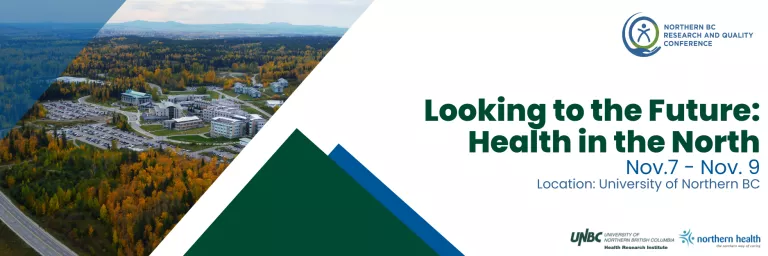
Concurrent Session D
Date: November 8
Time: 11:00am - 12:00pm
Location: University of Northern BC, 6-307
Theme: Innovative Health Care, Technology and Data Quality
Holly McVea
Title: The production of and quantification of anti-cancer compound moringin (4-(α-L-rhamnosyloxy)-benzyl isothiocyanate) in Moringa oliefera under laboratory conditions in Northern BC
Objective: To determine if moringin (4-(α-L-rhamnosyloxy)-benzyl isothiocyanate): an isothiocyanate that has been used to treat colorectal and breast cancer tumors in rats (Al-Asmari et al, 2015) could be produced under laboratory conditions in Northern, BC by growing Moringa oliefera without producing moringine (benzylamine) in the tree’s bark; moringine is a toxin allied to ephedrine (Aliyu et al, 2016).
Methods: Stem bark extracts were analyzed using FTIR and GC to identify and quantify 4-(α-L-rhamnosyloxy)-benzyl isothiocyanate (moringin) and benzylamine (moringine) in tissue.
Results: Bark extracts we produced contained an average of 0.08 mg/mL and up to 0.15 mg/mL of moringin, but the samples consisted of an average of 39.7% water; therefore, the concentration of moringin in solution was diluted. Double confirmation (through both FTIR and GC) that none of the bark samples contained moringine indicates that a greenhouse environment did not encourage the production of the potentially toxic compound.
Conclusion: The production of this anti-cancer compound (moringin) can be conducted anywhere in the world, as illustrated by our location in northern Canada, and is not limited to tropical growing conditions. There is potential for anti-cancer drug production in Northern BC via this inexpensive method of production.
Karina Hansen and Kelsey Sandhu
Title: Improving visualization of appendices via ultrasound at UHNBC
Methods: PDSA cycles were used to test change ideas including: introduction of a ‘cue sheet’ providing sonographers with reminders of appendix visualization techniques, focused education for sonographers on anatomical locations of the appendix and scanning techniques, trialing different patient preparation and positioning, and ‘double scanning’ (second sonographer performing a scan) when feasible and appropriate.
Results: The original project timeframe was May to November of 2022; however, after several months of low volumes of appendix ultrasounds, the team decided to extend the PDSA and data collection window until the end of April 2023. A strong upward trend in visualization emerged started in October 2022. Month over month visualization success increased an average of 4.8%, and as of the final month of data collection the success rate had reached 76.9%, representing a total increase in visualization of 42.4% from baseline.
Lessons Learned: Initially, sonographers were challenged in gaining hands-on experience with scanning, due to the relatively low frequency of appendix scans. Through facilitated whole team idea generation sessions at staff meetings, sonographers came up with the strategy of ‘double scanning’, whereby one sonographer would invite another to perform a secondary scan on the patient (when feasible and clinically appropriate). This strategy created opportunities for peer-to-peer learning, where sonographers learned from each other’s practices, thereby increasing the standardization between practices. Sonographers have found the practice of ‘double scanning’ to be so effective, that even after the completion of the project, they continue to employ this practice. Continuation of this practice is creating learning opportunities for new team members, and in turn sustainment of the improvement in visualization.
Galen Seilis
Title: Integrating Causal Inference Methods into Northern Health's Analytics Work
Objective: This talk aims to highlight the integration of modern causal inference methods into the decision-making processes at Northern Health (NH). I present a comprehensive approach to incorporate causal inference principles into NH's analytics work, emphasizing the significance of causality in healthcare research and its alignment with NH's mission, vision, and strategic plans.
Methods: The presentation outlines our approach, which involves the development of a systematic causal model development process. These methods are designed to equip NH's data scientists and researchers with the skills necessary to apply modern causal inference techniques effectively.
Results: I discuss the theoretical foundations and the framework for integrating modern causal inference methodologies into NH's projects. I highlight the general challenges and benefits of applying causal inference methods in healthcare research, including addressing incomplete or corrupted data, accounting for unmeasured confounds, and estimating heterogeneous treatment effects at the individual level. Finally, I will report on the current state of a project to estimate the causal impact of COVID-19 on a time series data set in NH.
Lessons Learned: Causality has deep roots in philosophy, and modern causal inference offers a rigorous framework to address the complexities of healthcare data analysis. I emphasize the critical distinction between causal inference and traditional statistics and demonstrate how misleading statistics can misguide decision-making. I stress that causal inference methodologies are in harmony with NH's mission, vision, and strategic objectives, enhancing the quality of inferences drawn from healthcare data.